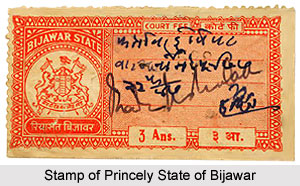 The Princely State of Bijawar was one of the well known 11 gun salute states of India</b> that was administered by a native prince under the guidance of the British authorities. The princely state was under the indirect control of the British Empire in India. The territory covered a total area of 2520 sq km and comprised of a total population of 120,990 in the year 1941. Bijawar state was located in the Bundelkhand region and included around 317 villages and 1 town in 1941. The state was founded by Bijai Singh, a Gond chieftain. The princely state was segmented 2 asymmetrical blocks by the northern range of the Vindhyan hills and included various enclaves. It was bounded by Orchha state in the west; by Chhatarpur in the east and northeast; and by Panna and the district of Saugor, Central Provinces in the south. The remote tahsil of Karaia made up the block of Bijawar territory. Bijawar State was incorporated as a part of the Bundelkhand Agency, which was a subdivision of the Central India Agency. The princely state of Bijawar covered an area of 973 sq miles in the Bundelkhand Agency. Almost half the total area of the region was covered with forests and was rich in minerals.
The Princely State of Bijawar was one of the well known 11 gun salute states of India</b> that was administered by a native prince under the guidance of the British authorities. The princely state was under the indirect control of the British Empire in India. The territory covered a total area of 2520 sq km and comprised of a total population of 120,990 in the year 1941. Bijawar state was located in the Bundelkhand region and included around 317 villages and 1 town in 1941. The state was founded by Bijai Singh, a Gond chieftain. The princely state was segmented 2 asymmetrical blocks by the northern range of the Vindhyan hills and included various enclaves. It was bounded by Orchha state in the west; by Chhatarpur in the east and northeast; and by Panna and the district of Saugor, Central Provinces in the south. The remote tahsil of Karaia made up the block of Bijawar territory. Bijawar State was incorporated as a part of the Bundelkhand Agency, which was a subdivision of the Central India Agency. The princely state of Bijawar covered an area of 973 sq miles in the Bundelkhand Agency. Almost half the total area of the region was covered with forests and was rich in minerals.
History of Princely State of Bijawar
The Princely State of Bijawar derives its name from the name of its founder Bijai Singh, a Gond chief of Garha Mandla during the 17th century. Bir Singh Deo, a Bundela Rajput, was the first ruler of the state. He was a descendant of the ruler of Orchha. The founder of Panna, Chhatarsal, who was a Rajput of the Bundela dynasty, conquered the region in the 18th century. The British East India Company confirmed Bijawar to Ratan Singh in the year 1811, for the usual deed of allegiance. As Bhan Pratap Singh, the native ruler of the state, provided loyal support to the British during the great revolt of 1857, he was rewarded with some privileges and was granted a hereditary salute of 11 guns. He was also given the title of Maharaja in 1866 and received the style of Sawai in the year 1877. After the death of Bhan Pratap Singh in 1899, he was succeeded by Sanwant Singh, who was his adopted son.
After the country achieved independence in the year 1947, the last ruler of the princely state was acceded to the newly formed Union of India on 1st January 1950. It was incorporated as a part of the state of Vindhya Pradesh; and later on 1st November 1956, Bijawar state was merged with Madhya Pradesh state.
Rulers of Princely State of Bijawar
The chronology of the native rulers of the princely state of Bijawar is mentioned below-
* Raja Bir Singh Deo (1769- 1793)
* Raja Himmat Bahadur (1793- 1802)
* Raja Keshri Singh (1802- 1810)
* Raja Ratan Singh (1811- 1833)
* Raja Lakshman Singh (1833- 1847)
* Raja Bham Pratap Singh (1847- 1866)
* Maharaja Bham Pratap Singh (1866- 1899)
* Sawai Maharaja Savant Singh (1900- 1940)
* Sawai Maharaj Govind Singh (1940- 1947)



















